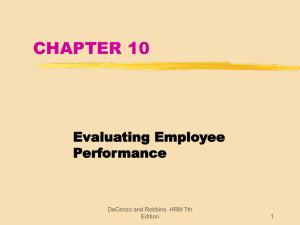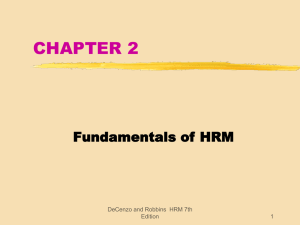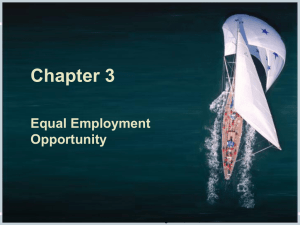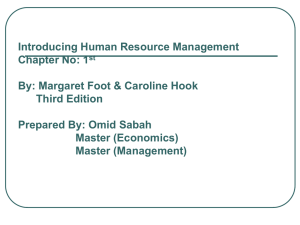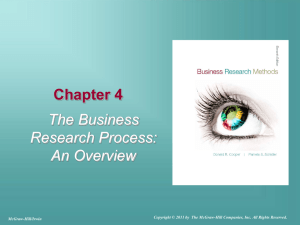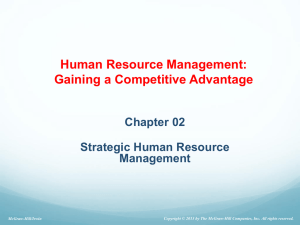Human Resource Management 10e.- Gary Dessler
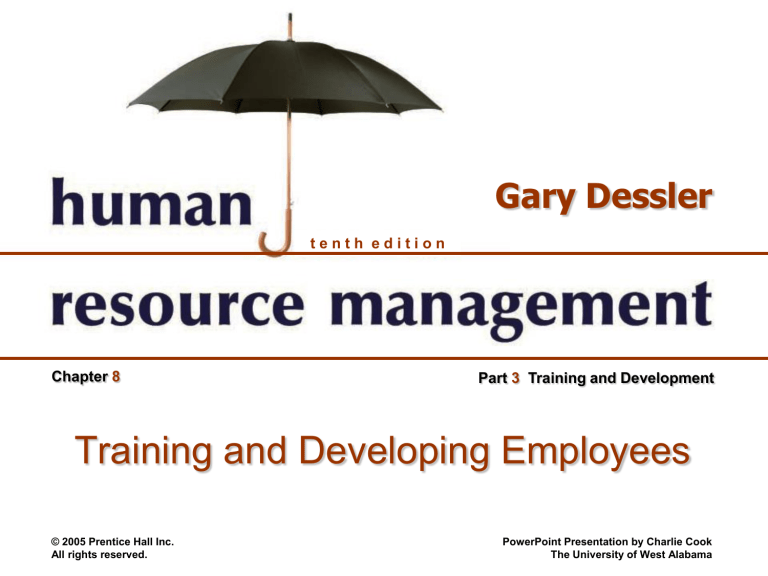
t e n t h e d i t i o n
Gary Dessler
Chapter 8 Part 3 Training and Development
Training and Developing Employees
© 2005 Prentice Hall Inc.
All rights reserved.
PowerPoint Presentation by Charlie Cook
The University of West Alabama
After studying this chapter, you should be able to:
1.
Describe the basic training process.
2.
Describe and illustrate how you would go about identifying training requirements.
3.
Explain how to distinguish between problems you can fix with training and those you can’t.
4.
Explain how to use five training techniques.
© 2005 Prentice Hall Inc. All rights reserved.
8 –2
Orienting Employees
Employee orientation
– A procedure for providing new employees with basic background information about the firm.
Orientation content
– Information on employee benefits
– Personnel policies
– The daily routine
– Company organization and operations
– Safety measures and regulations
– Facilities tour
© 2005 Prentice Hall Inc. All rights reserved.
8 –3
Orienting Employees (cont’d)
A successful orientation should accomplish four things for new employees:
– Make them feel welcome and at ease.
– Help them understand the organization in a broad sense.
– Make clear to them what is expected in terms of work and behavior.
– Help them begin the process of becoming socialized into the firm’s ways of acting and doing things.
© 2005 Prentice Hall Inc. All rights reserved.
8 –4
The Training Process
Training
– The process of teaching new employees the basic skills they need to perform their jobs.
The strategic context of training
– Performance management: the process employers use to make sure employees are working toward organizational goals.
• Web-based training
• Distance learning-based training
• On the job Training
• Off the job training etc.
© 2005 Prentice Hall Inc. All rights reserved.
8 –5
The Training and Development Process
Needs analysis
– Identify job performance skills needed, assess prospective trainees skills, and develop objectives.
Instructional design
– Produce the training program content, including workbooks, exercises, and activities.
Validation
– Presenting (trying out) the training to a small representative audience.
Implement the program
– Actually training the targeted employee group.
Evaluation
– Assesses the program’s successes or failures.
© 2005 Prentice Hall Inc. All rights reserved.
8 –6
Make the Learning Meaningful
At the start of training, provide a bird’s-eye view of the material to be presented to facilitates learning.
Use a variety of familiar examples.
Organize the information so you can present it logically, and in meaningful units.
Use terms and concepts that are already familiar to trainees.
Use as many visual aid as possible.
© 2005 Prentice Hall Inc. All rights reserved.
8 –7
EMPLOYEE TRAINING IMPORTANCE
Job complexity
Job changes
Employee diversity
Learning designed to produce a change
– Employee training
• Skills needed to do the job at hand
– Employee development ????????
DeCenzo and Robbins HRM 7th Edition 8
TRAINING NEEDS
Organization goals
Tasks to complete those goals
Behaviors needed to perform those tasks
Employee deficiencies in
– Skills
– Knowledge
– Abilities
DeCenzo and Robbins HRM 7th Edition 9
BEFORE YOU TRAIN…..
MAKE SURE
PERFORMANCE
DEFICIENCY IS DUE
TO LACK OF
TRAINING
DeCenzo and Robbins HRM 7th Edition 10
TRAINING APPROACHES (ON-THE-JOB)
Strengths
– Simple
– Actual job
Weaknesses
– Productivity
– Mistakes
Types
– Apprenticeship
– Job instruction training
DeCenzo and Robbins HRM 7th Edition 11
TRAINING APPROACHES (OFF-THE-JOB)
Classroom lectures
Films and videos
Demonstrations
Case studies
Simulations
Programmed instruction
– Interactive video disks
– Virtual reality
DeCenzo and Robbins HRM 7th Edition 12
AND…..
Computer-based training
–
See Exhibit 8-5
DeCenzo and Robbins HRM 7th Edition 13
Exhibit 8-5: Off-the-job Training Methods
DeCenzo and
Robbins
HRM 7th
Edition 14
EMPLOYEE DEVELOPMENT
Future oriented
Education, not training
– Reasoning, decision making
– Personal growth
All employees, not just managers
DeCenzo and Robbins HRM 7th Edition 15
EMPLOYEE DEVELOPMENT METHODS
Job rotation
Assistant-to positions
team assignment
AND…
DeCenzo and Robbins HRM 7th Edition 16
EMPLOYEE DEVELOPMENT METHODS
Lectures and seminars
AND….
DeCenzo and Robbins HRM 7th Edition 17
EMPLOYEE DEVELOPMENT METHODS
Coaching
Simulations
Outdoor training
DeCenzo and Robbins HRM 7th Edition 18
ORGANIZATION DEVELOPMENT
Goal is to help organizations
(people) adapt to change
Change affects
– Technology
– Systems
– People
– Processes
DeCenzo and Robbins HRM 7th Edition 19
ORGANIZATION DEVELOPMENT GOALS
– Help employees adapt to change
– Build acceptance of new culture
– Generate support for whatever actions need to be taken
DeCenzo and Robbins HRM 7th Edition 20
ORGANIZATION DEVELOPMENT
MODELS
Kurt Levin Change
Stages
• Unfreeze status quo
• Change
• Refreeze to stabilize
Rafting in white water
– Nimble, flexible, adaptable to survive
DeCenzo and Robbins HRM 7th Edition 21
ORGANIZATION DEVELOPMENT
METHODS
Climate surveys
Team building
Third-party intervention
Change agents
DeCenzo and Robbins HRM 7th Edition 22
OD - THE LEARNING ORGANIZATION
Systems thinking
Personal mastery
Mental models
Shared vision
Team learning
DeCenzo and Robbins HRM 7th Edition 23
OD - THE LEARNING ORGANIZATION
ORGANIZATION
DEVELOPMENT
BECOMES
ORGANIZATIONAL
TRANSFORMATION
DeCenzo and Robbins HRM 7th Edition 24
8: EVALUATING TRAINING AND
DEVELOPMENT
NEEDS TO BE
MORE THAN JUST
FUN
DeCenzo and Robbins HRM 7th Edition 25
8: EVALUATING TRAINING AND
DEVELOPMENT
OR NOT
DeCenzo and Robbins HRM 7th Edition 26
8: EVALUATING TRAINING AND
DEVELOPMENT
Cost effectiveness
Deficiencies corrected
Productivity measured
DeCenzo and Robbins HRM 7th Edition 27
8: POST-TRAINING PERFORMANCE
Train
Evaluate performance
DeCenzo and Robbins HRM 7th Edition 28
8: PRE-POST-TRAINING PERFORMANCE
Establish/identify baseline
Train
Evaluate performance
DeCenzo and Robbins HRM 7th Edition 29
8: PRE-POST-TRAINING WITH
CONTROL GROUP
Establish/identify baseline
Control group
– Hold out some subjects
– Do nothing to them
Train the rest
Evaluate performance of both groups
Compare results
DeCenzo and Robbins HRM 7th Edition 30
8: INTERNATIONAL ISSUES
Training
– Culture
– Language
– Techniques
Development
– Necessary for executives
– Expatriate
DeCenzo and Robbins HRM 7th Edition 31
What Is Management Development?
Management development
– Any attempt to improve current or future management performance by imparting knowledge, changing attitudes, or increasing skills.
Succession planning
– A process through which senior-level openings are planned for and eventually filled.
• Anticipate management needs
• Review firm’s management skills inventory
• Create replacement charts
• Begin management development
© 2005 Prentice Hall Inc. All rights reserved.
8 –32
Managerial on-the-Job Training
Job rotation
– Moving a trainee from department to department to broaden his or her experience and identify strong and weak points.
Coaching/Understudy approach
– The trainee works directly with a senior manager or with the person he or she is to replace; the latter is responsible for the trainee’s coaching.
Action learning
– Management trainees are allowed to work fulltime analyzing and solving problems in other departments.
© 2005 Prentice Hall Inc. All rights reserved.
8 –33
Off-the-Job Management Training and
Development Techniques
Case study method
– Managers are presented with a description of an organizational problem to diagnose and solve.
Management game
– Teams of managers compete by making computerized decisions regarding realistic but simulated situations.
Outside seminars
– Many companies and universities offer Web-based and traditional management development seminars and conferences.
© 2005 Prentice Hall Inc. All rights reserved.
8 –34
Off-the-Job Management Training and
Development Techniques (cont’d)
Role playing
– Creating a realistic situation in which trainees assume the roles of persons in that situation.
Behavior modeling
– Modeling: showing trainees the right (or “model”) way of doing something.
– Role playing: having trainees practice that way
– Social reinforcement: giving feedback on the trainees’ performance.
– Transfer of learning: Encouraging trainees apply their skills on the job.
© 2005 Prentice Hall Inc. All rights reserved.
8 –35
Off-the-Job Management Training and
Development Techniques (cont’d)
Corporate universities
– Provides a means for conveniently coordinating all the company’s training efforts and delivering Webbased modules that cover topics from strategic management to mentoring.
In-house development centers
– A company-based method for exposing prospective managers to realistic exercises to develop improved management skills.
© 2005 Prentice Hall Inc. All rights reserved.
8 –36
Off-the-Job Management Training and
Development Techniques (cont’d)
Executive coaches
– An outside consultant who questions the executive’s boss, peers, subordinates, and
(sometimes) family in order to identify the executive’s strengths and weaknesses.
– Counsels the executive so he or she can capitalize on those strengths and overcome the weaknesses.
© 2005 Prentice Hall Inc. All rights reserved.
8 –37
Managing Organizational Change and
Development
What to change?
– Strategy: mission and vision
– Culture: new corporate values
– Structure: departmental structure, coordination, span of control, reporting relationships, tasks, decision-making procedures
– Technologies: new systems and methods
– Employees: changes in employee attitudes and skills
© 2005 Prentice Hall Inc. All rights reserved.
8 –38
Overcoming Resistance to Change
What causes resistance?
– All behavior in organizations is a product of two kinds of forces—those striving to maintain the status quo and those pushing for change.
Lewin’s Change Process
– Unfreezing: reducing the forces striving to maintain the status quo.
– Moving: developing new behaviors, values, and attitudes, sometimes through structural changes.
– Refreezing: reinforcing the changes.
© 2005 Prentice Hall Inc. All rights reserved.
8 –39
Overcoming Resistance to Change
Change initiatives
– Political campaign: creating a coalition strong enough to support and guide the initiative.
– Marketing campaign: tapping into employees’ thoughts and feelings and also effectively communicating messages about the prospective program’s theme and benefits.
– Military campaign: Deploying executives’ scarce resources of attention and time to actually carry out the change.
© 2005 Prentice Hall Inc. All rights reserved.
8 –40
How to Lead the Change (in 10 Steps)
1.
Establish a sense of urgency.
2.
Mobilize commitment through joint diagnosis of problems.
3.
Create a guiding coalition. / team
4.
Develop a shared vision.
5.
Communicate the vision.
6.
Help employees to make the change.
7.
Generate short-term wins.
8.
Consolidate gains and produce more change.
9.
Anchor the new ways of doing things in the company’s culture.
10.
Monitor progress and adjust the vision as required.
© 2005 Prentice Hall Inc. All rights reserved.
8 –41
Key Terms employee orientation training performance management negligent training task analysis performance analysis on-the-job training apprenticeship training job instruction training (JIT) programmed learning simulated training job aid electronic performance support systems (EPSS) management development succession planning job rotation action learning case study method management game role playing behavior modeling in-house development center outsourced learning organizational development controlled experimentation
© 2005 Prentice Hall Inc. All rights reserved.
8 –42


